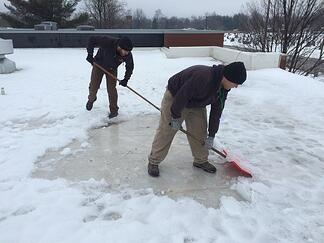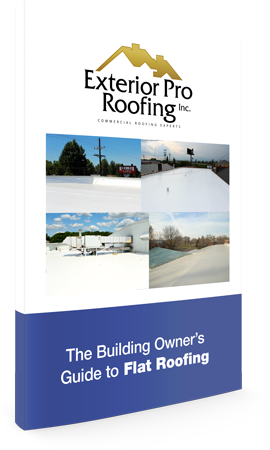The problems
 Flat roof systems are designed to quickly shed rainwater as well as melted snow and ice through their downspouts and drains. But even if they're designed to do so, ice and snow doesn't drain until it melts. If it's been a harder winter than average, as this one has been, snow and ice may not have a chance to melt and drain before it continues to accumulate on the roof, to the point that the roof could leak, lose structural integrity and collapse.
Flat roof systems are designed to quickly shed rainwater as well as melted snow and ice through their downspouts and drains. But even if they're designed to do so, ice and snow doesn't drain until it melts. If it's been a harder winter than average, as this one has been, snow and ice may not have a chance to melt and drain before it continues to accumulate on the roof, to the point that the roof could leak, lose structural integrity and collapse.
Even if the snow load isn't causing immediate problems, you may find other issues that pop up. If you're seeing leaks, it could be because an ice dam has formed over a warmer area of your roof, keeping water from draining. Trying to remove the ice dam on your own could cause serious damage to a commercial flat roof system. Though it's possible to remove the snow and ice, ice is slippery and snow can be heavy, increasing your chances of hospital bills or a worker's comp claim if you or an employee climbs onto the roof to remove the snow. It's a much better idea to leave the bulk of the snow removal to the professionals.
Tips and tricks

- If you can reach, use a shop broom or dedicated snow blade to remove snow from porch and lean-to commercial flat roofs. These roofs can often be reached from ground level, reducing slip-and-fall risks to workers.
- If you have a leak form, be sure to get a container underneath it to keep your business' floor dry. One clever idea is to place a rain barrel underneath it with a hose running to a drain, allowing the water to drain off as it falls and preventing damaging overflows.
- If you hear any unusual noises from your roof or if it doesn't look right from underneath, get people out and keep them out until you can have the snow removed professionally and your roof inspected. Taking the chance that it will be okay is a recipe for a lawsuit.
Hiring the right contractor
If you do have to hire a contractor to remove snow and ice from your roof, you want to be sure you're hiring the right one. Here are some things to look for:- A contractor with a history in your area. Fly-by-night operations will often do a bad job, damage your roof, sue for injuries because they don't have proper insurance or even leave town with your money.
- Check with the Better Business Bureau to see whether the company has any complaints lodged against them.
- Ask to see licenses, certifications and insurance documents. A good contractor will happily provide these for your perusal.
Now that you know what to do to get your roof cleared of snow and ice, it's time to put that knowledge into action. Assess the situation, fix what you can and get a good contractor to deal with the rest.







